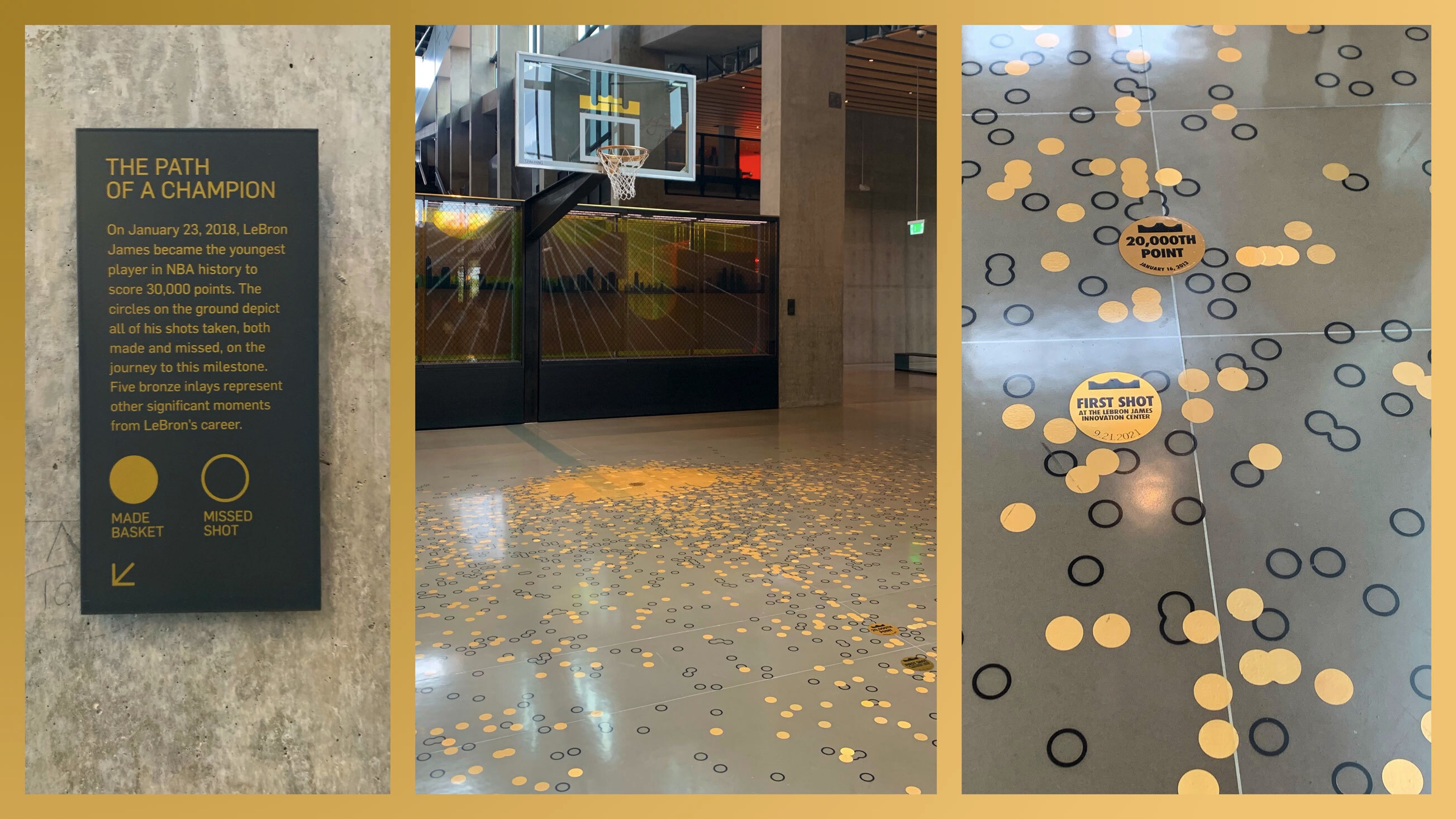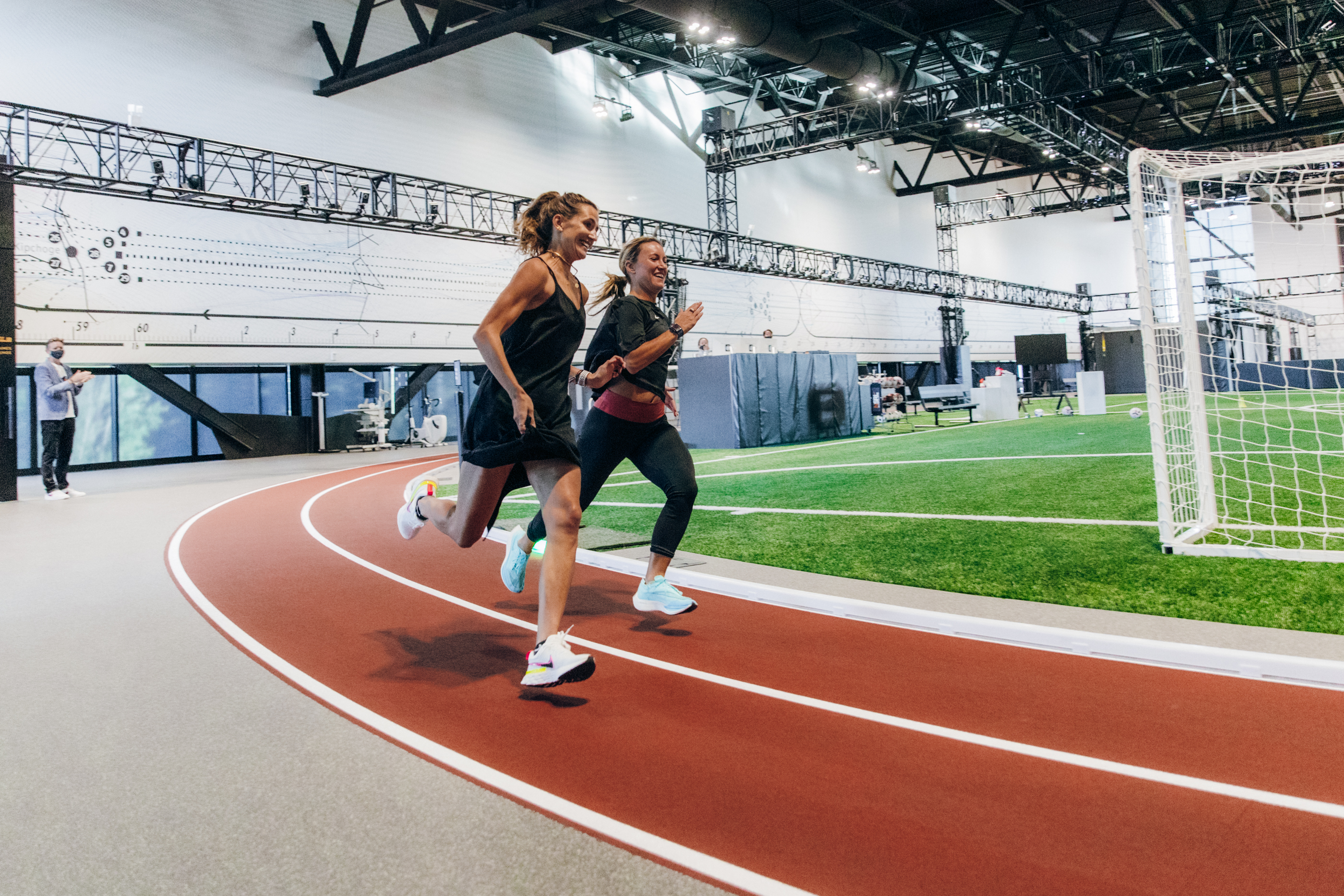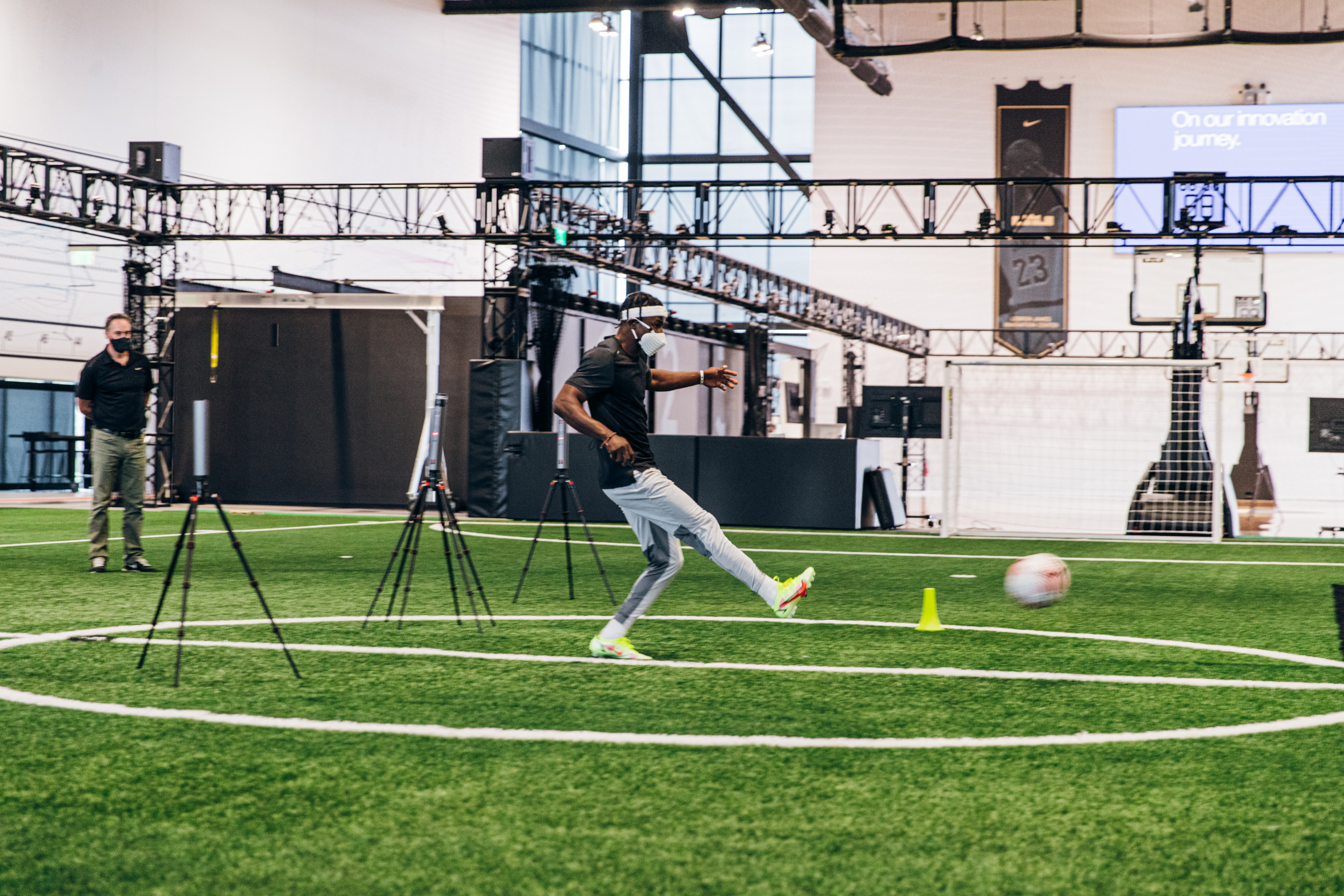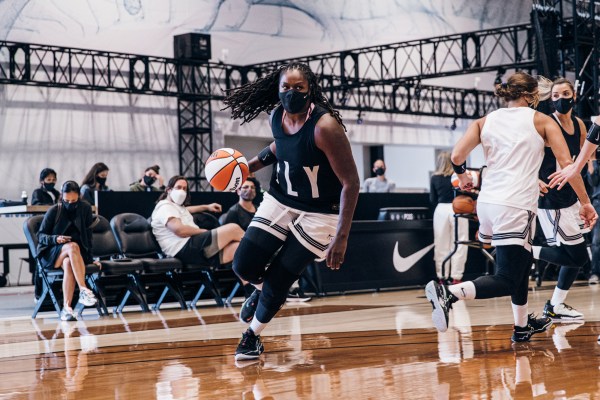Eight years ago, Nike decided it was time to expand the Nike Sports Research Lab (NSRL), which was housed in the Mia Hamm building across company headquarters.
Now a full five times the size of its former self, the NSRL, which occupies the top floor of the brand-new LeBron James Innovation Center, is big enough to allow collaboration among athletes, researchers and innovators as they develop the products we wear every day.
Studying soccer stars like Megan Rapinoe and the world’s fastest marathon runner Eliud Kipchoge — for everything from the differences in millimeters between each of their feet to the amount of force projected every time their feet touch the ground — helps researchers develop guidelines that help creators design apparel and footwear to enhance performance. Athletes also train with the support of Nike scientists in order to learn more about themselves and their bodies to benefit their performance.
But the NSRL is not just for the world’s elite athletes; it’s for those who play pick-up basketball games on concrete courts in city parks, neighborhood runners and expectant and new parents like those highlighted in Nike’s “The Toughest Athlete” film.
Matt Nurse, vice president of the Nike Explore Team Sport Research Lab, says there are times Nike tries to pursue a deeper understanding more quickly.
“The other type of science is this big data, observational stuff using machine learning or AI to start to understand lots of different inventions for movement.”
He says 80% to 85% of the people who come through the lab are everyday athletes from different backgrounds with diverse body types. With a plan to bring thousands of active bodies through the door, Nike can increase the learnings and the speed of development with the new space.
Nike recently invited members of the media to experience firsthand how athletes, researchers and innovators interact to develop Nike products.

Entrance to the LeBron James Innovation Center. Image Credits: Rae Witte / Composite: Bryce Durbin/TechCrunch
The entranceway of the 750,000-square-foot LeBron James Innovation Center sets the tone for Nike’s commitment, nearly a decade in the making, to utilizing data and design for innovation.
Every one of James’ shot attempts that led to his 30,000 professional career points is mapped on the polished concrete floor in front of a golden hoop. Shots are differentiated by golden dots and empty zeros, representative of points made and missed. Milestone moments are highlighted with larger captioned markers on the floor, including his first made shot and his 20,000th point.
Above the main floor are the apparel and footwear prototypes: Designers and creators occupy spaces with robotics and 3D printers, as well as knit, textile and embroidery sections. There is even a replica of the Winnebago that Nike co-founder Phil Knight traveled to track meets in. Once there, he’d pass out the earliest iterations of Nike footwear in order to get feedback from the athletes.
The 84,000-square-foot NSRL occupies the top floor of the building and is where researchers and athletes come together to develop Nike footwear and attire. The NSRL includes a full-size, NBA regulation court, a 200-meter track, climate chambers and artificial training turf. These areas contain a combination of 92 force plates, 400 motion capture cameras and 80 prototyping machines.
Force plates, which Nurse describes as glorified bathroom scales, are located beneath the surface of the track, turf and basketball courts. Unlike the typical bathroom scale that offers one reading when you step on it, he says, “these measure tens of thousands of times a second in three dimensions. So not just straight up and down but side to side, back and front.”
For example, for a runner on the track, they’d be able to measure the force with which the foot is connecting and pushing off the ground.
The additional space in the NSRL allows for more fluid and less restricted gameplay and movement.
“One of the goals here is to allow athletes to come in full speed, full motion and also [in] continuous play,” Nurse said. “Sometimes in small facilities, the movements become choreographed, and that’s it. Now, we can have people come in and play.”
Sweating in the lab
To inform researchers how all of the tools within the space are leveraged for controlled experimentation and observational big data collection, Nurse said they try to understand three pillars of the triangle: “What’s the dose, what’s the behavior and what’s the response. If we have the dose, response and behavior, a prototype has to give us enough information to do that. We think it’s a solution to look for problems.”
On our tour of the lab, we underwent some of the same testing that Nike designed for its athletes, which included work on the basketball court, track and turf and in the treadmill bays.
We started with a collection of baseline data: a full body scan to determine optimal Nike apparel fit; morphological body size tracking and skeletal and muscular asymmetries; a separate, three-dimensional scan of my feet and ankles; and a barefoot walking pressure test before the Applied Performance Innovation Treadmill. I chose a comfortable speed for a jog and was instructed to run for two to three minutes while they recorded it for analysis.
Researchers can provide observations on form, such as whether athletes are too bouncy, run on their toes or lean forward too much.
They can also make functional recommendations. For example, a runner who leans forward too much may need to strengthen their glutes or hamstrings for a more efficient gait.
Based on what they know biomechanically and through their algorithm development to understand products and athletes, using this testing combined with the baseline data, researchers can make footwear recommendations for optimal efficiency — whether that’s running faster, longer and/or with less stress on the body.
The track
The track itself surrounds both the turf and the basketball court, and it features force plates and motion capture cameras that can be utilized for long runs or more segmented testing, such as starts. An LED Rabbit or pacer offers another layer of control to experiments, and there’s a 100-meter concrete strip to simulate running outdoors.
On the track I was able to test out two different footwear options. Their Infinity Reacts are meant for protection, lower stress on the body and stability. I was able to make it around the track at a comfortable rate in front of the Nike Run Club average runner’s mile pace of 11:37 and well behind sub-2-hour marathoner Eliud Kipchoge’s pace, as indicated by a glowing green LED pacer that spun around the track all day.
However, when I attempted to do a lap with the elite runner’s race shoe of choice, the ZoomX Invincible, we discovered that the cushion system — made to be super lightweight with a carbon plate within their exaggerated foam and air system sole — was not a match for the mechanics of my feet.
The construction, which lends optimal efficiency for some, afforded me — admittedly a non-runner despite finding I have decent form — and my very narrow feet, previously injured ankle and flexible (or what I think are loose or weak) ankles a very unstable running experience. I didn’t even complete the 200-meter lap.

Athletes run on the track at the Nike Sport Research Lab. Image Credits: Nike
This is where the range of athletes is so crucial. Studying a runner like Kipchoge is incredibly valuable. Because he is so physically efficient, he doesn’t need five hours to complete a marathon and so hasn’t ever run that long. But the global average marathon runner clocks in somewhere between 4 hours and 20 minutes to 4 hours and 40 minutes.
This wide range of data collection will inform footwear innovations through multiple sets of shoes, enabling Nike to develop running shoes appropriate for any runner, whether they’re an elite marathoner or a casual jogger.
The turf
The Turf Lab boasts the largest data capture volume in the NSRL and what Nike says may be the largest in the world. Here, force plates below the surface monitor game play and more controlled experiments, allowing researchers to collect data on up to 22 players — the amount on a soccer field during gameplay — who are moving at different speeds and directions while interacting with each other, the turf, the cleats and the ball. The turf also has a screen where targets can be projected and accuracy can be recorded for shooting and passing.
Two things Nike specifically focuses on for soccer players’ footwear are functionally very different — the sole for traction and the type of movement the upper requires for dribbling, passing and kicking.

Simulating a shot at a goal in the Nike Sport Research Lab. Image Credits: Nike
The 200 cameras surrounding the area capture submillimeter movement, and below the turf are 15 force plates. By measuring an athlete’s movement in a controlled environment, researchers can drill down into the tiniest changes to make for performance and for protection, and a lot of the findings can apply to other field sports like baseball, football and rugby.
During the soccer test, I simulated the opportunity to take a shot on goal. This included a shuttle run as if I were tackling a defender, running around a defender and then taking the shot at a target projected on a screen within the goal.
In this simulation, they captured the forces when I was cutting back, the timing and agility throughout the route, the timing of my decision-making upon the appearance of the target and the accuracy of the ball with respect to the target.
The results of this test will speak to the size of the athlete, how explosive they are and how quickly they can push off the force plate beneath them. The power, in addition to the traction of the footwear, translates into the speed of their movement. If the traction were to be insufficient, the same level of force would result in a slower speed.
A shoe with really good traction but poor containment, afforded by the shoes’ upper, will result in the foot sliding within the shoe, because while the footwear is interacting with the ground efficiently, the foot is not.
By contrast, an upper providing good containment and poor traction will fit the foot, but will result in the shoe sliding on the ground. The data allows for alterations like these to be made to the footwear.
The basketball court
The force plates beneath the neighboring basketball court capture similar data for basketball players.
Fully surrounded by motion capture cameras, players wear sensors that track their heart rates and the speed of their movements on the court, which can be projected in real time on a large screen on the wall. In addition to those, a force plate with a 4K camera below it is under the hoop and can record the way in which a sneaker sole interacts with the floor.
Coupled with the motion sensor tracking data throughout the drill, depending on the stiffness of the sneaker or the thickness of the sole, they can track how speed is affected by the footwear, and observe and see the sole’s connection to the floor all while the sensor tracks the athlete’s heart rate throughout the movements.
Another camera in the hoop records the position of the ball as it goes through. The data collected from these shots provide suggestions on functional adjustments that result in a more consistent and efficient shot going through the hoop.
[gallery ids="2222918,2222924,2222919,2222920,2222921,2222922,2222923"]
The climate chambers
Understanding moisture management needs between different wearers offers designers guidelines to create more functional clothing. We toured two climate chambers, one hot and the other cold, that can regulate temperature from -20 to over 50 degrees Celsius; humidity from 10%-90%; control wind speed; and simulate the radiant heat of the sun using two different types of bulbs that match the spectral outlet of the sun’s rays.
The chambers can be set to such precision that their hot tank on the day we visited was set to 34 degrees Celsius and 70% humidity — the exact weather conditions on August 6 in Tokyo during this summer’s Olympic Games where some staff and athletes had to be treated for heat exhaustion.
Leveraging the climate chambers allows Nike to evaluate how different apparel designs or zoning of features can have the biggest impact on making garments more breathable.
Because sweating helps to regulate body temperature, the hot chamber is used to study sweating responses in consumers and how they vary based on sex, age and body size.
They showed us their Vapor Match Men’s Soccer jersey, pointing out where the changes in the knit were zoned to the most condensed perspiration areas, which can be seen in the third image here.
Conversely, the Nike NSRL Transform Jacket exhibits the manifestation of the different thermal needs for an outside run. Sleeves that zip off and tuck into chambers on the back of the jacket and removable down fill accommodates the transition from stepping outside to plateau. They’ve found that the day-to-day runner averages about 5 kilometers per run, and the biggest shift in their insulation needs is between start and 2.5 to 3 kilometers. After that, it regulates for the remainder of the exercise, which is also the case for those running beyond 5 kilometers.
Finally, they have thermal mannequins — that sweat! — in order to test zoning features without having to put stress on human bodies. Between the climate control and the bodies to test on that never tire, they’re able to give design teams even more to work with.
The cool down
We hear a lot about mental toughness in the world of sport, so it makes sense Nike would want to understand the minds of their athletes, too, particularly as they impact performance.
Studies and recovery at NSRL go far beyond massage, acupuncture and other bodily needs of rest and maintenance that are available in the lab. They’re also taking into account their subjects’ mental state.
Mental health has become a factor in discussions about elite athletes in the media, whether it’s Naomi Osaka opting out of press conferences or Simone Biles being open about her need to sit out the women’s all-around final at the 2020 Summer Olympics.
Before taking my baseline measurements, they gave me a cognitive assessment, and at the close of the day, we went through the learnings. Surprisingly (and probably by design), the assessment translates easily between both athletes in regard to sports as it does everyday human behavior.
In pointing out how uncertainty is often so much greater than certainty, the team discussed decision-making and how different results could point to whether an athlete is more prone to decision-making from a place of loss prevention or risk aversion.
These findings can similarly be applied to cognitive recommendations, much like the form or functional recommendations other tests offered. Not only are they trying to create better apparel and footwear, the lab is committed to furthering all aspects of athletes’ abilities.
For example, an athlete struggling with a need for control can try to focus less on the outcome itself and more on the fact that the outcome can be leveraged as an opportunity to benefit future competitions or even process. Similarly, rather than dwelling on a moment or missed shot, sport psychologists will recommend employing mental imagery or visualizing the positive outcome for the future.
Ultimately, the new LeBron James Innovation Center will aid in athletes’ well-being and progress as much as it will afford faster innovations of Nike’s apparel and shoes.
As everything is approached with steps to greater opportunities rather than ticking problems off a list with the entire team in one building, it will be incredible to see what the future holds for the space and its output.

Lobby of the LeBron James Innovation Center. Image Credits: Nike
